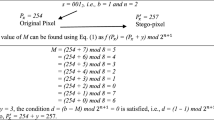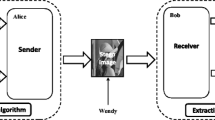Abstract
This paper proposes two pixel value differencing (PVD) steganography techniques by considering adaptive ranges to improve the security. In the first technique, the image is partitioned into 2 × 2 pixel blocks in a non-overlapping fashion and scanned in raster-scan order. For every 2 × 2 pixel block the left-upper and bottom-right corner pixels are targetted based on their correlation with the other two pixels. Both horizontal and vertical edges are considered. In the second technique, the image is partitioned into blocks with 3 × 3 pixels in an overlapped fashion and scanned in raster-scan order. For a block the central pixel is targetted for embedding. Both the horizontal and vertical edges are inspected, but one of them is considered for data embedding at the target pixel. The ranges are adaptively calculated based upon the local statistics of the blocks. The first technique provides higher hiding capacity and the second technique provides higher peak signal-to-noise ratio value.











Similar content being viewed by others
References
Balasubramanian C, Selvakumar S, Geetha S (2013) High payload image steganography with reduced distortion using octonary pixel pairing scheme. Multimed Tools Appl. doi:10.1007/s11042-013-1640-4
Chang KC, Chang CP, Huang PS, Tu TM (2008) A novel image steganography method using tri-way pixel value differencing. J Multimed 3(2):37–44
Chang CC, Tseng HW (2004) A steganographic method for digital images using side match. Pattern Recogn Lett 25(12):1431–1437
Fridrich J, Goljian M, Du R (2001) Detecting LSB steganography in color and gray-scale images. Mag IEEE Multimed Secur 8:22–28
Khodaei M, Faez K (2012) New adaptive steganographic method using least-significant-bit substitution and pixel-value differencing. IET Image Process 6(6):677–686
Lee YP, Lee JC, Chen WK, Chang KC, Su IJ, Chang CP (2012) High-payload image hiding with quality recovery using tri-way pixel-value differencing. Inf Sci 191:214–225
Liao X, Wen QY, Zhang J (2011) A steganographic method for digital images with four-pixel differencing and modified LSB Substitution. J Vis Commun Image Represent 22:1–8
Luo W, Huang F, Huang J (2010) A more secure steganography based on adaptive pixel-value differencing scheme. Multimed Tools Appl 52:407–430
Qin C, Chang C-C, Huang Y-H, Liao L-T (2013) An inpainting-assisted reversible steganographic scheme using a histogram shifting mechanism. IEEE Trans Circ Syst Video Technol 23(7):1109–1118
Qin C, Chang C-C, Chiu Y-P (2014) A novel joint data-hiding and compression scheme based on SMVQ and image inpainting. IEEE Trans Image Process 23(3):969–978
Shen SY, Huang LH (2015) A data hiding scheme using pixel value differencing and improving exploiting modification directions. Comput Secur 48:131–141
Swain G (2013) Steganography in digital images using maximum difference of neighboring pixel values. Int J Secur Appl 7(6):285–294
Swain G (2014) Digital image steganography using nine-pixel differencing and modified LSB Substitution. Indian J Sci Technol 7(9):1444–1450
Swain G, Lenka SK (2012) LSB array based image steganography technique by exploring the four least significant bits. CCIS 270(2):479–488
Swain G, Lenka SK (2012) A technique for secret communication by using a new block cipher with dynamic steganography. Int J Secur Appl 6(2):1–12
Swain G, Lenka SK (2013) Steganography using two sided, three sided, and four sided side match methods. CSI Trans ICT 1(2):127–133
Swain G, Lenka SK (2014) Classification of spatial domain image steganography techniques: a study. Int J Comput Sci Eng Technol 5(3):219–232
Swain G, Lenka SK (2015) A novel steganography technique by mapping words with LSB array. Int J Signal Imaging Syst Eng 8(1/2):115–122
Tseng HW, Leng HS (2013) A steganographic method based on pixel-value differencing and the perfect square number. J Appl Math, Article ID 189706, 8 pages
Westfeld A, Pfitzmann A (2000) Attacks on steganographic systems. Lect Notes Comput Sci 1768:61–76
Wu DC, Tsai WH (2003) A steganograhic method for images by pixel value differencing. Pattern Recogn Lett 24(9–10):1613–1626
Wu HC, Wu NI, Tsai CS, Hwang MS (2005) Image steganographic scheme based on pixel-value differencing and LSB replacement methods. IEEE Proc Vis Image Sig Process 152(5):611–615
Xia Z, Wang X, Sun X, Liu Q, Xiong N (2014) Steganalysis of LSB matching using differences between nonadjacent pixels. Multimed Tools Appl. doi:10.1007/s11042-014-2381-8
Xia Z, Wang X, Sun X, Wang B (2014) Steganalysis of least significant bit matching using multi‐order differences. Secur Commun Netw 7(8):1283–1291
Yang CH, Weng CY, Wang SJ, Sun HM (2010) Varied PVD + LSB evading programs to spatial domain in data embedding systems. J Syst Softw 83:1635–1643
Zhang X, Wang S (2004) Vulnerability of pixel-value differencing steganography to histogram analysis and modification for enhanced security. Pattern Recogn Lett 25:331–339
Author information
Authors and Affiliations
Corresponding author
Rights and permissions
About this article
Cite this article
Swain, G. Adaptive pixel value differencing steganography using both vertical and horizontal edges. Multimed Tools Appl 75, 13541–13556 (2016). https://doi.org/10.1007/s11042-015-2937-2
Received:
Revised:
Accepted:
Published:
Issue Date:
DOI: https://doi.org/10.1007/s11042-015-2937-2




